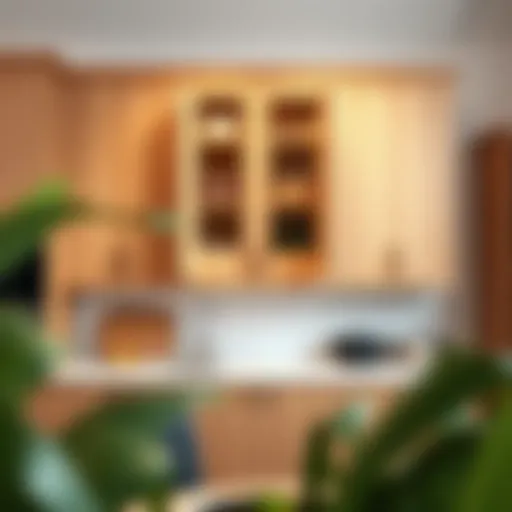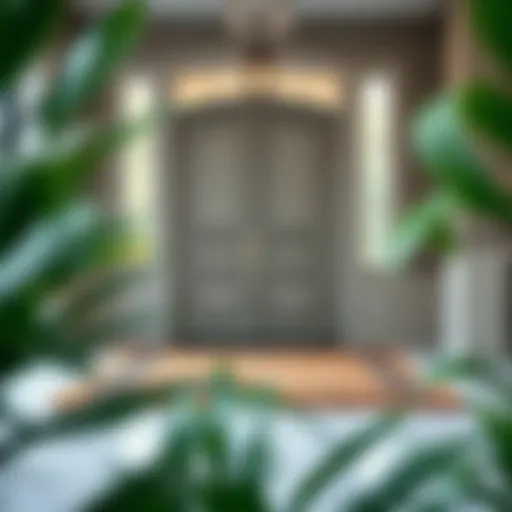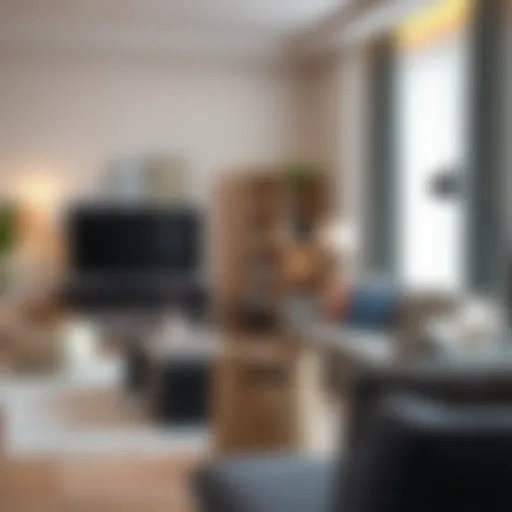Versatile 36 Inch Window Valances for Modern Decor
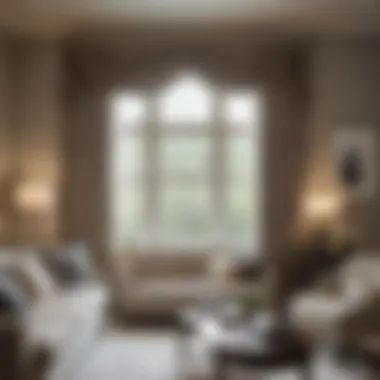

Intro
In the realm of home decoration, it can be easy to overlook the subtle charm that window treatments bring to a space. Yet, when considering the allure of 36-inch window valances, one begins to realize how these relatively simple fabric pieces can elevate an entire room's aesthetic. Not only do they add a polished finish to windows, but they also serve practical purposes, like providing shade and hiding hardware. Whether you're a homeowner looking to refresh your living room or a designer eager to mix styles, understanding valances is essential.
This article dives into the appeal of 36-inch window valances, shedding light on their versatility in various settings, from cozy kitchens to elegant living rooms. The significance of color coordination and material choice will also be explored, alongside practical tips for installation and maintenance. For those inclined toward DIY projects, we’ll delve into how you can customize valances to align with your unique taste. Readers will find insights not only into current trends but also into how they can express their style through these decorative yet functional elements.
Preface to Window Treatments
When it comes to outfitting a home, window treatments often don’t get the attention they truly deserve. Yet, they play a vital role in not just aesthetics but also in the functionality of a space.
The importance of choosing the right window treatments cannot be overstated. They serve as a first line of defense against external elements. For instance, a good treatment keeps light and heat in check, which can help regulate indoor temperatures and contribute to energy efficiency. An effectively installed valance, like the 36 inch variety discussed in this article, doesn’t just shield the room from sunlight but also artfully frames a window, adding depth and character to a room that might otherwise feel flat.
Moreover, window treatments can also enhance privacy. Not everyone wants passersby peeking in, especially in more intimate spaces like bedrooms or living rooms. Here, thoughtful design elements become functional necessities.
Additionally, they also reflect personal style. From bold patterns that make a statement to subtle hues that complement the overall décor, the choices available can be overwhelming yet exciting. Thus, window treatments become a canvas for creativity, enabling homeowners and designers to express individual personalities and tastes.
The Importance of Window Treatments
Window treatments serve multiple functions. They're not merely decorative elements but essential components of a well-thought-out design scheme. They provide:
- Light Control: Depending on the fabric and style, they can filter in light or block it out completely.
- Temperature Regulation: Especially those that have an insulating effect can help maintain a comfortable indoor climate.
- Privacy: A quality valance can obscure the view without being too heavy-handed.
- Aesthetic Appeal: They complete the look of a space, providing that finishing touch that ties everything together.
The right window treatment can either enhance or disrupt the overall ambiance of a room. A well-chosen valance, for instance, can draw the eye upward, creating an illusion of higher ceilings.
"Window treatments are like the icing on the cake for a beautifully decorated room."
With this understanding, it’s clear that choosing the right valance, especially a 36 inch one, is not just important; it is essential to achieving the desired atmosphere in a home.
Different Types of Window Treatments
There is a wealth of options available when it comes to window treatments, each with its unique charm and function. Here are a few popular types:
- Curtains and Drapes: Often used for their elegance, curtains and drapes can dramatically change a room’s appearance. They can be sheer for softness or heavier for warmth.
- Blinds: Functional and easy to operate, blinds come in various materials, including wood and faux wood. They provide excellent light control and privacy.
- Shades: Similar to blinds but usually made from fabric. They can be rolled up or down, offering flexibility.
- Valances: These are short treatments that can top off other window coverings or stand alone. Available in countless styles, they can add a pop of color or pattern to your design.
Each window treatment type has its advantages, making it important to consider not just aesthetics but also how well they perform for the specific needs of the space.
Understanding Valances
Window valances are often an overlooked aspect of interior design, yet they play a pivotal role in enhancing the overall aesthetic of a room. Understanding the nuances of valances is essential for homeowners, designers, and DIY enthusiasts alike, as these decorative elements can significantly impact the vibe and functionality of living spaces. This section dives into what valances are, their purpose, and how they have evolved over time.
Definition and Function
A valance is essentially a short piece of fabric or material that covers the uppermost part of a window, hiding the hardware such as rods or brackets that hold the curtains. They come in a variety of designs, materials, and styles, serving both functional and decorative purposes.
The main functions of window valances include:
- Concealing Hardware: Valances provide a polished look by camouflaging the functional elements of window treatments.
- Adding Style: Available in numerous patterns, colors, and textures, valances offer a quick way to introduce elegance or whimsy to a room.
- Enhancing Light Control: While they do not block light significantly, they can help control how much light enters through the top of a window when paired with blinds or shades.
- Defining Spaces: Valances can serve as visual anchors in a room, helping to delineate zones such as dining areas or seating arrangements.
One of the beauties of valances is their ability to complement other window treatments, including drapes and shades, bringing a coordinated look to your interiors.
History and Evolution
Historically, valances date back to the ornate designs of the 18th century, where they adorned the grand windows of castles and manors. Initially, these fabric treatments were symbols of opulence, meticulously crafted from luxurious materials embroidered with intricate patterns. As time progressed, their purpose shifted; while they continued to evoke sophistication, they also adapted to emerging design trends.
In the early 20th century, valances began to take on a more casual look, aligning with the trend of simpler, more functional home designs. With the advent of mid-century modernism, valances even shed their fabric-only look. Today, they can be made from various materials, including wood and metal, expanding their applicability far beyond traditional fabric.
As the understanding of home décor has evolved, so has the role of valances. They seamlessly transition between traditional elegance and modern minimalism, reflecting the tastes of contemporary homeowners. This adaptability allows valances to fit into diverse design styles, from rustic farmhouse to sleek industrial chic.
"Valances are more than just fabric on the window; they are an articulate statement of style and taste that complements the entire decor scheme."
In sum, understanding what valances are and how they function allows homeowners to make informed choices when decorating their spaces. Whether you're looking for a dash of color or a more sophisticated air, 36-inch valances can cater to all these needs.
Specifics of Inch Valances
When it comes to enhancing the aesthetic appeal of windows, 36 inch valances represent a unique blend of functionality and style. These window treatments can dramatically alter the mood of a room, providing a polished look that can complement any design scheme. Understanding the specifics of these valances not only informs your decorating choices but also shapes how well they integrate within your space. A keen attention to dimensions and suitability for window sizes can genuinely elevate your home’s interior appearance.
Dimensions and Proportions
The dimensions of a 36 inch valance are not arbitrary; they play a crucial role in establishing harmony within your room's design. The width of 36 inches is generally suitable for standard-sized windows, making it an ideal choice for most domestic settings. However, it’s vital to consider how the valance will sit against the window frame.
- Length: The length of the valance should also be taken into account. While 36 inches is the stock length, some designs may benefit from a longer or shorter cut.
- Height: Usually, valances might range in height from 12 to 18 inches, which allows them to add significant visual interest without overpowering the window itself.
Like adding the perfect seasoning to a dish, the proportions of a valance can either enhance or detract from your overall look. If you're using these in tight, cozy spaces, for instance, a valance that’s too long could make the room feel cramped.
Ideal Window Sizes for Inch Valances
Knowing the right window sizes is just as critical as dimensions when it comes to 36 inch valances. Though they are versatile, these valances shine when matched with certain window types.
Perfect Window Sizes:
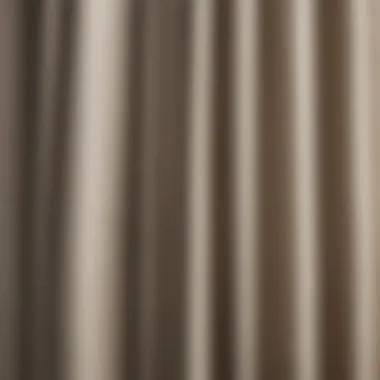

- Standard double-hung windows typically measure around 30 to 36 inches wide, making them a great candidate.
- Picture windows can also benefit well if they fall into this width range, providing a crisp finish at the top.
- Even small sliding glass doors can be dressed up nicely without taking away the natural light they allow in.
It’s important to remember that while 36 inches is a standard length, these valances can be used creatively. If your windows deviate in size, consider altering the valance’s appearance or choosing complementary window treatments to achieve the desired aesthetic.
"A valance isn't just a decorative item; it can redefine the boundaries of your room's style when chosen thoughtfully."
In integrating these elements of 36 inch valances, one can appreciate the depth and nuance they bring to window decor. Careful consideration of dimensions and window sizes will enable a harmonious blend of style and function, allowing these instruments of decor to shine in any setting.
Design Versatility of Inch Valances
When it comes to window treatments, design versatility stands out as one of the main draws of 36 inch valances. A well-chosen valance can harmonize with different interior styles, amplify the aesthetics of your space, and express personal taste without overwhelming the room. They serve more than a mere decorative function; they can set the tone for the entire room, making them a valuable consideration for homeowners and designers alike.
Style Variations: From Classic to Modern
Valances come in an array of styles that can seamlessly integrate into both classic and modern designs. For a classic decor theme, options like ruffled or swaged valances bring nostalgia to the forefront. They can be made from traditional fabrics such as damask or toile, adding sophistication and warmth. Colors that are muted or pastels tend to work well here, creating a timeless appeal.
In contrast, modern designs often favor cleaner lines and bold colors. Geometric patterns or minimalistic valances made from synthetic materials, like canvas or polyester, can resonate well within a minimalist framework. Functional yet stylish, these valances contribute to a sleek finish without distracting from other decor elements.
- Classic Style Examples:
- Modern Style Examples:
- Ruffled valances in soft florals
- Swagged curtains in rich, velvety hues
- Straight-cut valances in bright, solid colors
- Patterned fabrics with abstract designs
Integrating Valances with Other écor
The ability to incorporate 36 inch valances into existing décor is a sought-after trait among designers and homeowners. A valance can act as a bridge between different elements in a room, allowing for harmonious decor coordination.
When integrating valances into your decor:
- Complementary Colors: Select colors that resonate with other elements, such as wall paint or upholstery. This creates visual cohesion across the room.
- Mixing Textures: Combining different materials, like pairing a silk valance with wooden blinds, can add depth and interest to your space.
- Layering Window Treatments: Using valances atop blinds or sheer curtains can provide extra dimension, achieving both aesthetic appeal and privacy.
Having a well-planned integration strategy can make or break the final look of a space. So, think about that before rushing to pick out your next valance. After all, it’s those thoughtful details that often make the biggest impression.
Materials Used in Making Valances
Understanding the materials employed in the construction of window valances is crucial, not only for aesthetic purposes but also for functionality. The right material can set the mood of a room, providing a cozy feel, or add a layered touch to a modern design. The selection of materials can significantly affect the durability, maintenance needs, and overall visual appeal of valances. As homeowners, designers, or DIY enthusiasts consider the options available, recognizing the pros and cons of various materials becomes imperative.
Fabric Choices and Their Aesthetics
Fabric is perhaps the most common choice for valances, and its versatility should not be underestimated. Numerous types of fabric such as cotton, linen, polyester, and velvet are widely used. Each of these fabrics has its unique characteristics:
- Cotton: Known for its breathability and soft texture, cotton valances can introduce a casual vibe to any space. They are machine washable, making maintenance simple.
- Linen: This fabric offers a more rustic and organic feel. It drapes beautifully but can be prone to wrinkling, which is a point to consider if a polished look is desired.
- Polyester: Resistant to wrinkles and fading, polyester is a practical choice for those who prefer a low-maintenance option. This fabric can easily mimic the look of natural fibers but often at a more cost-effective price.
- Velvet: For a touch of luxury, velvet valances are hard to beat. They add depth and richness to a room but may require special care to clean and maintain.
The right choice of fabric can not only enhance the aesthetics of the valance but also contribute to the room's overall atmosphere. A light and airy fabric might work well in a sunroom, while a heavier velvet fabric could complement a more traditional space.
Alternative Materials: Wood, Metal, and More
In contrast to fabrics, alternative materials such as wood and metal can offer exciting options that break the mold of traditional valances. These materials typically bring a different set of attributes:
- Wood: Wooden valances can add warmth and a sense of craftsmanship to a room. They are available in various finishes and styles, from rustic barn wood to sleek modern designs. For practical and aesthetic consideration, they should be treated to resist moisture, particularly in high-humidity areas like kitchens or bathrooms.
- Metal: Valances made from materials such as aluminum or wrought iron can introduce a contemporary edge. They can come in various finishes and styles and are also easy to clean. This type of valance can work beautifully in industrial or minimalist designs.
Both wood and metal options also tend to be more sturdy, offering durability that most fabrics simply cannot match, especially in high-use areas.
Installation Techniques for Valances
When it comes to window treatments, installation techniques for valances hold significant weight in how the final look complements a space. Valances, particularly those that measure 36 inches, require attention to various specifics to ensure they fulfill both their aesthetic and functional roles. Knowing how to properly install these pieces can make all the difference, enhancing the overall design while contributing to effective functionality. Proper installation ensures that the valance hangs neatly, catches the eye, and frames the window beautifully, elevating the room’s decor.
Tools and Materials Required
Before diving into the installation, gathering all necessary tools and materials simplifies the process. Here’s a list tailored to properly install your valance:
- Valance: Choose the right fabric or material based on your design vision.
- Curtain Rod or Mounting Bracket: A sturdy rod or bracket suited for the weight of your valance is essential.
- Measuring Tape: To ensure precise placement.
- Level: To keep things straight.
- Pencil: For marking positions without permanent marks.
- Drill and Drill Bits: Needed for creating holes in the wall.
- Screws and Anchors: To hold the mounting bracket securely.
- Stud Finder: Optional, but helpful in finding a sturdy mounting location.
With all tools at hand, it’s time to get down to the nitty-gritty of the installation.
Step-by-Step Installation Guide
For those who prefer a hands-on approach, here’s a straightforward step-by-step guide to installing your 36-inch valance:
- Measure and Mark: Start by measuring the width of your window to determine the width of the valance. Use your measuring tape to find the desired height at which the valance will hang, then mark the brackets' placement points with your pencil. Make sure these points are level, ensuring your valance will hang straight.
- Install the Brackets: If you’re using a mounting bracket, use a drill to install it according to the marks you've made. Make sure to use screws and wall anchors properly to secure it to your wall. If you're unsure about drilling directly into your walls, consider using adhesive hooks designed for curtain rods as a less invasive option.
- Hang the Valance: After successfully installing the brackets, it's time to place the valance onto the curtain rod or hook. Ensure it’s seated properly without any bunching. This step may require a second pair of hands to hold it in place while you adjust.
- Adjust and Style: Once the valance is hung, step back and evaluate its placement. Make adjustments if necessary to achieve your desired look. Feel free to fluff or shape the fabric to get that perfect style.
- Final Touches: Double-check the level and alignment of the valance one last time. Make sure everything looks just right, and enjoy how the new installation enhances your space.
By following these steps with care, your 36-inch window valance will not only accentuate your windows but will also be a reflection of your personal style. The impact is far-reaching, turning an ordinary space into something inviting and stylish.
Maintenance and Care of Valances
Maintaining window valances is more than just a chore; it's a vital part of ensuring they continue to enhance your home’s aesthetic appeal. Valances not only frame windows beautifully but also serve practical functions like hiding hardware, blocking light, and adding a finishing touch to your décor. Over time, they can gather dust, stains, or even wear out. Hence, understanding how to care for them effectively is indispensable.
Cleaning Different Types of Materials
The cleaning method for a valance largely depends on the material it’s made from. Here’s a breakdown of popular materials and specific cleaning tips:
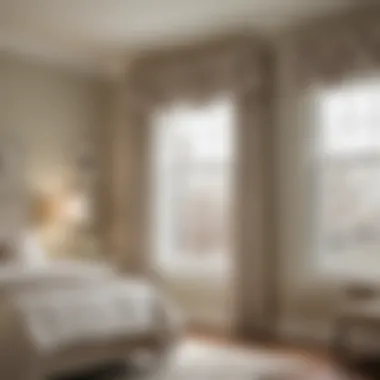

- Fabric: Many fabric valances can simply go into the washing machine. Use gentle cycles for delicate fabrics like silk or lace. For sturdier materials like cotton or polyester, warm water should do the trick. Always check care labels first. If machine washing isn't an option, a vacuum with a brush attachment can help remove dust.
- Wood: Wooden valances, while striking, require more effort. They shouldn't get wet, so a dry microfiber cloth is your best friend here. For more thorough cleaning, a wood-specific cleaner will maintain that polished look.
- Metal: Clean metal valances with a damp cloth, followed by a dry one. Avoid harsh chemicals that can scratch or tarnish the finish.
- Vinyl: For vinyl options, use a soft cloth with warm soapy water to wipe down the surface, making it easy to remove stubborn stains.
Tips:
- Avoid exposing your valances to excessive sunlight, as it may lead to fading or discoloration.
"A little regular care goes a long way!"
Repairing and Maintaining Valances
When it comes to keeping your valances looking sharp, repairs can be just as important as initial cleaning. Here are some pointers on maintenance and how to tackle common issues:
- Stitching Loose Threads: If you notice loose threads, don’t ignore them. A few stitches using a needle and thread can make a mountain of difference in appearance.
- Replacing Hooks or Clips: If hooks become bent or clips break, replacing them can be done in a jiffy. These small parts are often sold at home improvement stores and can extend the life of your valance significantly.
- Restoring Shape: Sometimes, valances lose their intended shapes. Quick steam treatment can bring them back to life, giving them that crisp, full appearance again.
In essence, making valances part of your home upkeep routine can keep them fresh and functional. Regular care not only enhances your space but also allows you to enjoy the fashion statement they provide longer.
Color Coordination with Valances
When it comes to decorating your home, color coordination isn't just a nice-to-have; it's a pivotal aspect that can transform the overall ambiance of a room. Valances serve as the crown jewels above your windows, and their colors can either harmonize with your decor or clash catastrophically. This section will illuminate why thoughtful color coordination with 36-inch valances is crucial, how it can enhance your space, and what elements you should keep in mind.
Understanding Color Theory for Home écor
At its core, color theory is a framework that explains how colors interact with one another. It’s about emotions, styles, and personal resonance. When you choose a valance, think beyond just what looks pretty.
- Primary Colors: Red, blue, and yellow are your building blocks. Mixing them creates secondary colors, which can add depth.
- Complementary Colors: Opposites on the color wheel, these hues boost each other. A blue valance with accents of orange—wow factor!
- Analogous Colors: Three colors next to each other, like green, blue-green, and blue, make for seamless transitions.
Each of these color relationships can bring a distinct feeling to your space. For example, utilizing analogous colors can create a soothing space, perfect for a bedroom.
"Choosing the right colors for your valances can turn a drab room into a vibrant sanctuary."
Choosing Colors for Your Space: Tips and Tricks
When it comes to pairing your 36-inch valances with your existing color scheme, there are several strategies you can employ:
- Evaluate Your Existing Palette: Before you rush to pick out colors, take a good, hard look at what’s already in the room. Paint colors, furniture, and flooring all play a role.
- Consider Lighting: Natural light can significantly change how a color appears. Test your valance color in different lighting conditions to see how it evolves throughout the day.
- Don’t Forget Textures: Sometimes, a color looks entirely different based on the material. A silk valance might reflect light in a way that cotton won’t.
- Use a Color Wheel: Keep one handy for instance. This simple tool can quickly help you visualize which colors will complement each other, without a degree in art.
- Incorporate Patterns: If you choose patterned valances, make sure to pull from the colors in the patterns for a cohesive look. Tie a floral valance into solid-colored cushions or throws around the room.
Whether you favor bold statements or a subtle touch, remember that color coordination takes time and thought. Slapping on any old hue just won’t cut it if you aim for a well-designed space.
Current Trends in Valance Design
Understanding the current trends in valance design is crucial for homeowners, designers, and DIY enthusiasts alike. The humble valance has evolved significantly over the years, transcending its basic function to become a focal point in interior design. As styles shift and tastes change, it’s the trends in valance design that help determine how these window adornments can best enhance living spaces.
With a vast array of options available, it is vital to keep abreast of popular patterns, styles, and sustainable practices. These trends not only inform the choices available today but also reflect broader societal shifts towards sustainability and personalization in home decor.
Popular Patterns and Styles
When it comes to valance styles, the options seem nearly endless. Contemporary designs are leaning towards patterns that add character without overwhelming the space. Here are some noteworthy trends:
- Geometric Patterns: Clean lines and structured shapes in fabrics lend a modern flair. These patterns can bring an airy feel and often work great in complementing minimalist aesthetics.
- Floral Designs: While florals are a perennial favorite, the current trend favors oversized prints. This adds a bold touch while combining rustic charm with modern elements.
- Textured Fabrics: Materials like linen, burlap, and velvet are back on the scene, offering both an aesthetic upgrade and enhanced functionality. They can add depth and warmth to any room.
Using the right patterns can transform a space. Consider pairing a striped valance with solid curtains for a balanced look, or opt for a floral valance to bring a touch of nature indoors.
"Personalizing your space is about more than aesthetics. It reflects who you are and how you feel at home."
Sustainable Practices in Valance Production
As the world pivots towards sustainability, the production of window valances is no exception. Here’s how current trends are shaping a greener approach to valance design:
- Eco-Friendly Materials: Many manufacturers now offer valances made from organic cotton, recycled polyester, and non-toxic dyes, catering to environmentally conscious consumers.
- Local Sourcing: Buying locally not only reduces carbon footprint but also supports regional artisans and small businesses. When sourced nearby, these valances often come with unique designs that lend personality to a space.
- Durability Over Fast Fashion: There's a notable shift away from disposable decor. Homeowners are focusing on high-quality, durable products that stand the test of time. Investing in well-made valances means fewer replacements, reducing waste in the long run.
In summary, current trends in valance design reflect an interplay between aesthetics and functionality. As homeowners look to elevate their spaces with style, they also prioritize sustainability, ensuring that their choices leave a lighter footprint on the planet.
DIY Projects: Crafting Your Own Valances
The journey into home décor can often lead one to discover the charm of mastering your own decorative elements. When it comes to achieving a personal touch in your living space, crafting your own valances stands out as a fulfilling endeavor. DIY projects offer a chance not just to save money but to express creativity, turning mere fabric into a statement piece that reflects the owner's taste. Making valances also lets you tailor designs that adapt perfectly to your window dimensions, ensuring a snug fit that off-the-shelf options might not provide.
Engaging in DIY crafting brings other rewarding aspects. It encourages resourcefulness, allowing you to choose materials that blend with your furnishings. Moreover, this process posits oneself into a meditative state, where the simple act of cutting fabric and sewing can become strangely therapeutic. As odd as it may sound, the focus and patience needed to create something from scratch fosters a sense of achievement and pride.
Materials Needed for DIY Valances
When diving into the creation of valances, the selection of materials plays a significant role in achieving a successful outcome. Here’s a quick rundown of essential items:
- Fabric: Choose wisely! Cotton is often favored for its versatility and ease of use, while linen provides a more sophisticated appearance.
- Tape Measure: So you won't be caught in a floppy situation.
- Scissors or Rotary Cutter: Because precision is your friend here.
- Sewing Machine: This is not a task for those needle and thread alone—unless you enjoy sewing as a real test of patience.
- Thread: Match your chosen fabric in color.
- Valance Rod or Curtain Rod: To ensure your valances hang just right.
- Decorative Features (Optional): Think about adding trims, tassels, or even decorative buttons for flair.
With these tools in hand, the groundwork for crafting your own valances becomes a tangible reality.
Design Ideas for Custom Valances
Getting into the creativity of crafting means unrestricted possibilities. Here are some design ideas that can serve as inspiration for your unique valances:
- Roman Valance: A styled and structured drop that provides a chic, tailored look. Using a single fabric ensures a clean design, while you can play with the pattern placement to guide the eye.
- Layered Valances: Combine two or more fabrics to create a layered effect, mixing textures and colors to add depth and interest.
- Pelmet Box Style: This takes a bit of woodworking, but building a pelmet box to hide curtain hardware can elevate your design to a different league altogether.
- Patchwork Approach: Embrace scrap materials! You can craft a delightful patchwork valance, weaving stories of materials together, stitching memories with every fabric piece selected.
- Floral Prints: For a breezy, fresh feel, opt for floral prints that carry the essence of nature inside, aligning with the season or theme of the room.


Ultimately, the crafting process transforms not just your windows, but your entire creative landscape at home. DIY projects, like these fabric valances, invite a freshness, a personal story woven in layers.
Despite any occasional hiccup with measurements or stitching, the outcome can become a cherished part of your home's narrative. As the saying goes, "If you can dream it, you can do it.” So why not let your windows tell a story of personal flair?
Incorporating Valances into Different Rooms
Adding valances to your interiors isn't merely about aesthetics; it’s about enhancing the overall ambiance of a room. Valances carry a unique ability to frame windows and elevate decor, while also allowing for practical benefits like light control. As we delve deeper into how various spaces can be enriched using 36-inch window valances, it’s crucial to understand their versatility in design and function.
Living Room Applications
In the living room, where gatherings and conversations flow, 36-inch valances can act as a statement piece. They offer an opportunity to bring together different design elements, tying together colors from upholstery, artwork, or decor pieces. For instance, a lush, patterned fabric valance can complement throw pillows on a couch, creating a harmonious visual link throughout the room.
When selecting a valance for the living room, consider the height and style of the room. A valance installed above the window frame can make the space appear taller, which is beneficial in rooms with lower ceilings. Additionally, combining less elaborate valances with heavier drapes can help manage light better while maintaining an inviting atmosphere.
"A well-chosen valance can transform an ordinary window into a focal point of a room."
Kitchen and Dining Room Considerations
In kitchens and dining areas, function meets style. Often, these spaces are bustling with activity, and adding valances can help strike a balance between practicality and decor. Bright, cheerful fabrics can refresh a kitchen, providing a splash of color that beautifully contrasts with wooden cabinetry or stainless steel appliances.
Valances in these areas also serve a purpose beyond aesthetics. Because kitchens tend to generate grease and grime, selecting a fabric that's easy to clean is advisable. Alternatively, wooden or metal valance options provide a sleek, modern aesthetic while ensuring durability. Additionally, consider open shelving or light fixtures harmonizing the valance to promote visual unity.
Bedroom Style and Functionality
Bedrooms are sanctuaries, and the right window treatments can significantly impact the room's atmosphere. Using 36-inch valances can lend an air of sophistication and coziness to this space. Soft fabrics in serene colors can create a soothing retreat, while richer hues can evoke warmth and intimacy.
Consider layering valances with blackout curtains or shades to enhance privacy and light control, providing a restful environment. When deciding on designs for the bedroom, think about how patterns or colors tie into the overall theme of the room. For instance, a floral valance can echo the theme of a rustic setting, while sleek, solid colors can match contemporary designs.
Ultimately, the charm of incorporating valances into different rooms lies in the ability to augment each space's individuality while providing necessary functionality. Various styles, materials, and arrangements allow homeowners and designers alike to tailor their approach, ensuring every room is chic and inviting.
Cost Considerations for Valances
When it comes to enhancing your home’s aesthetic, 36-inch window valances can play a pivotal role. However, it's crucial to take cost into account. This section dissects the various financial aspects associated with selecting, installing, and maintaining these stylish window treatments, helping you navigate the otherwise murky waters of interior design expenditure.
Budgeting for Valances
Setting a budget is step one in the journey of purchasing window valances. You need to consider several factors:
- Material Choice: The fabric used can significantly affect the price. For instance, cotton may be more affordable compared to silk or linen, which can run up the bill substantially.
- Style and Design: Simple, minimalist designs often cost less than elaborate, tailored options. If your heart's set on intricate patterns or bespoke styles, you may end up spending a pretty penny.
- Size Considerations: While 36-inch valances are standard, any custom measurements can boost costs. It’s essential to accurately measure your windows to avoid unnecessary expenses later on.
- Labor Costs: If you’re not feeling up to the task of installation, hiring a professional can add to the overall expenditure.
Creating a clear budget helps set realistic expectations, ensuring you find a beautiful valance that suits your financial boundaries.
Comparative Analysis of Custom vs. Ready-Made Valances
Choosing between custom and ready-made valances can feel like picking between apples and oranges. Here’s a closer look at both options:
Ready-Made Valances:
These are often more cost-effective. They come in set sizes and designs, which means you can find something that fits most windows without needing alterations. Additionally, many retailers offer a wide selection so finding a compatible style isn’t too tough.
- Pros:
- Cons:
- Generally lower cost
- Quick availability
- No need for custom measurements
- Limited options in terms of size and style
- Potential fit issues for unique window shapes
Custom Valances:
Custom-made options may offer a plethora of design possibilities but come with a heftier price tag. From unique fabrics to tailoring for an exact fit, they allow for a great deal of individual creativity.
- Pros:
- Cons:
- Tailored for your exact specifications
- Unique designs only limited by your imagination
- Higher cost associated with manufacturing and materials
- Longer wait times due to fabrication
In summary, if budget constraints are tight, a ready-made valance might serve as a good alternative. If personalization and exactitude matter most to you, it could be worth splurging on a custom option. Ultimately, weighing the pros and cons in relation to your space and style objectives will guide you in making an informed choice.
The End: The Impact of Valances in Home Design
When it comes to home design, 36-inch window valances can be the cherry on top of a well-decorated space. They are not merely ornamental; their function extends into the realm of enhancing aesthetic appeal and providing a cohesive look within various themed interiors. Valances serve as the finishing touch that balances everything, drawing attention upwards and making a room feel more complete. By placing a valance over your window treatment, you effectively frame your window and, by extension, your view, inviting light while maintaining a certain level of privacy.
A noteworthy point is that valances pair well with different styles, whether you lean toward modern minimalism or classic elegance. This versatility allows homeowners and designers alike to get creative with fabric choices, colors, and patterns. While you might find floral prints resonating with a country-style kitchen, a sleek, solid fabric could enhance the sophistication of a contemporary living room.
Additionally, using valances provides the functional benefits of insulation and sun protection. While their primary role is decorative, a well-chosen fabric can help control the temperature in a room and reduce glare from sunlight, which is especially essential in spaces where screens or delicate furnishings are present.
Overall, the impact of 36-inch window valances in home design is multifaceted, making them more than just a decorative accessory. They compliment and elevate a room's overall design scheme, thus underlining the importance of thoughtful selection and application with regard to your home's style.
Final Thoughts on Aesthetic Value
In the realm of aesthetics, a well-placed 36-inch valance can contribute significantly to the overarching vibe of any room. It's these subtleties that catch the eye—softening stark window frames or adding a pop of color to a neutral palette. The valance’s ability to cater to various design sensibilities is noteworthy. From the luxurious draping of silk to the crisp lines of cotton blends, the texture and color can either complement or contrast existing elements in a room.
Using a valance as an accent not only adds to the aesthetic value but can also tie together disparate aspects of a room's design. For example, a valance that echoes the upholstery on your couch or matching bedding in your bedroom can seamlessly unite the space.
Encouraging Thoughtful Decorating Choices
When it comes to incorporating 36-inch window valances into your home, mindful decision-making goes a long way. Start by considering the overall style and functionality of the space. A combination of comfort and style should be your guiding principle when choosing materials and colors.
- Reflect on texture: Adding different textures can create depth in your design. For instance, a tactile fabric against smooth walls might evoke warmth and comfort.
- Color coordination: Think about the role color plays in your home environment. Subtle hues can create tranquility, while brighter shades may inject energy into a space.
- Personal style: Ultimately, your home should represent you. Opt for valances that resonate with your personality, whether that means whimsical prints for creativity or sleek designs for a modern approach.
"A home is not just where you live; it's how you express yourself. Valances can play a crucial role in that expression."









